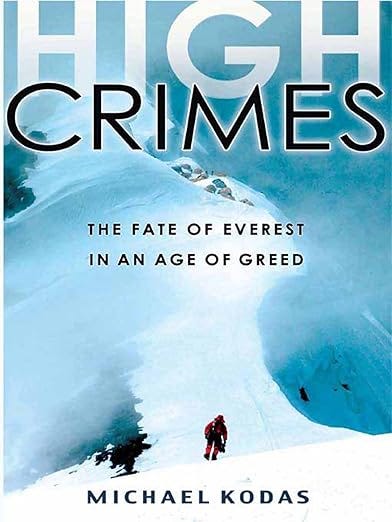Cheddar & Jalapeno Focaccia & High Crimes
A look at bad behaviour on the roof of the world, and a spicy, cheesy round of focaccia
Hello and welcome to Good Book Good Bread!
I’ve been in a phase recently where I’ve been reading a lot of great books that came out years ago. My bedside table has been occupied by White Oleander by Janet Finch (1999), The Other Side of the Bridge by Mary Lawson (2006), Summer Sisters by Judy Blume (1998), and this issue’s feature, High Crimes by Michael Kodas (2008). It’s a double-edged sword falling in love with a book that debuted so long ago—it feels like you’re discovering a gem, but then you have fewer people to talk about it with.
High Crimes was vivid, fascinating, and shocking, and I think I’m going to remember many details of this book forever. Check out my full review below of this look at bad behaviour on Mount Everest, and scroll to the bottom to see what bread I baked to go with High Crimes.
Plus: I’ve launched a bread baking YouTube channel! Check it out below and subscribe to get notified when I post a new video, from focaccia to milk bread to pizza to bagels!👇
Good Book: High Crimes: The Fate of Everest in an Age of Greed by Michael Kodas (2008)
High Crimes in a Nutshell
High Crimes is an investigative account of the darker side of modern mountaineering on the world’s most sought-after summit. Following a tumultuous 2004 assignment for the Hartford Courant where he joined an Everest expedition, Kodas looks at the cutthroat side of the mountain’s ecosystem. He intertwines two powerful narratives: the tragic abandonment and death of climber Nils Antezana at the hands of an unscrupulous guide, and the disintegration of his own expedition under volatile leadership. Amidst base-camp theft, violence, faulty oxygen supplies, and instances of disturbing indifference toward dying climbers in the “Death Zone,” Kodas paints a portrait of a mountain overwhelmed by commercialization and ego. His suspenseful prose forces readers to confront how a rush to summit may have eroded the integrity of what was once a noble, exploratory pursuit.
High Crimes in Three Words
Scary, immersive, thrilling
What I liked about High Crimes
1. First hand account
The most chilling part of this book for me was reading about Kodas’ experience being part of a deeply dysfunctional Everest expedition. His guide was mercurial and unpredictable, and the group atmosphere deteriorated to the point that Kodas feared for his safety. As someone who likes to drive myself everywhere because I hate the idea of being stuck in a situation I don’t like, the idea of being on a mountain with a maniacal guide is a literal nightmare.
2. Characterization of individualism on Everest
Kodas tells many stories of people in the Death Zone who are only able to look out for themselves. His descriptions of mountaineers stepping over bodies on the way to the top and stealing oxygen from one another illustrated how on the world’s highest peak, being a team player isn’t always the focus. Whether it was caused by lack of oxygen to the brain, physical deterioration, a singular fixation on their goal, or all of the above, this inability to help others struck me as terrifying.
3. Investigation into a guide who abandoned his client
I thought the most well-done part of High Crimes was the investigative element where Kodas delves into the background of a guide who let his client die on Everest. Gustavo Lisi was a scoundrel of a climbing guide who after a failed Everest attempt then stole the summit photo of a dying climber. He tried to pass off the bundled-up person in the image as himself.
In 2004, he led Nils Antezana to the top of Everest, but then left his client who was struggling to die near the summit. Lisi didn’t try to rescue Antezana, and instead got back to base camp and immediately posted a celebratory message to his website with no mention of Antezana. Kodas explores the background of Lisi, connects with Antezana’s grieving relatives, and illustrates how easy it was for an unqualified guide to make his way to Everest with paying clients.
Good Bread: Cheddar & Jalapeno Focaccia
Why this book for this bread?
So much of the mayhem in High Crimes occurs when mountaineers are deprived of oxygen and unable to think with their full faculties. I thought a bread whose success also hinges on air (CO2 bubbles created during fermentation, to be exact) would be a great fit for this book.
Recipe for cheddar jalapeno focaccia
For the focaccia, I used Alison Roman’s overnight focaccia tonight, recipe. You can check it out here. After dimpling the dough, I added about 1 cup of cubed cheddar cheese, and diced jalapeno rings from one pepper. If you like heat, keep the seeds. If not, discard them before you add to the dough. I also added a few cranks of black pepper. I always admire the gorgeous round focaccia loaves at my favourite local bakery, so tried my hand at baking this one in a springform and it turned out great.
Watch my cheddar jalapeno foccaccia being made
Looking forward:
Book I’m looking forward to reading: Good Things, Samin Nostrat’s next cookbook!
Show I’m looking forward to watching: The Pitt
Bread I’m looking forward to baking: Rooti Farmaajo (honeycomb cheese bread, here, drool)
Thank you for reading! If you liked this issue, forward along to a friend. If you hated it, please forward along to an enemy.








This sounds brilliant, thanks for the recommendation!